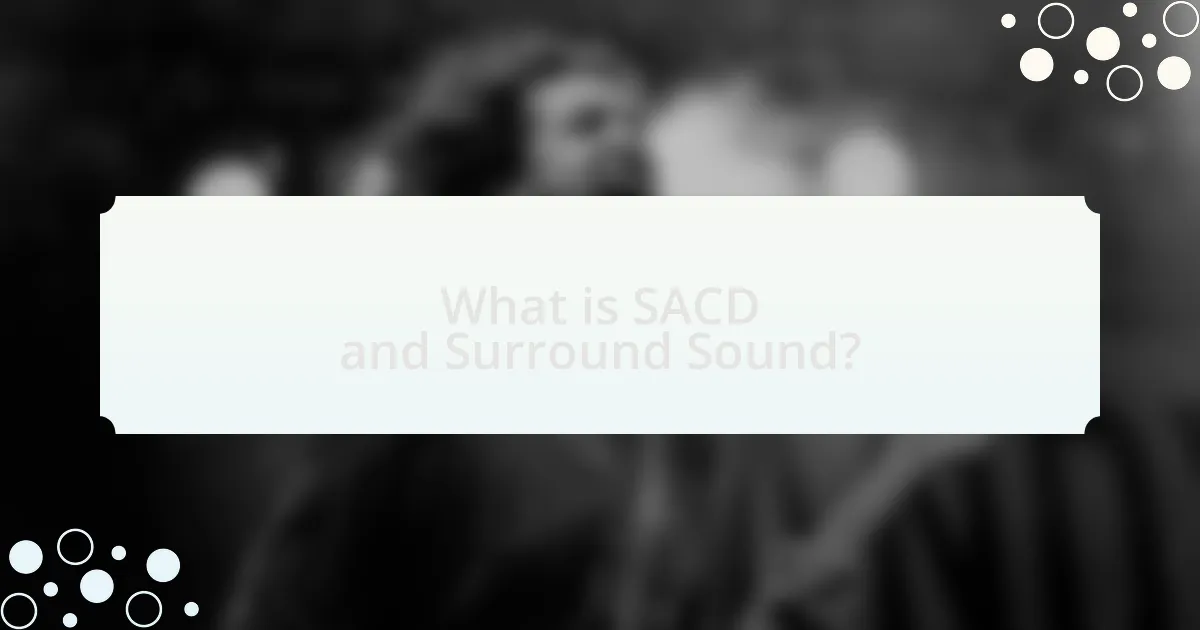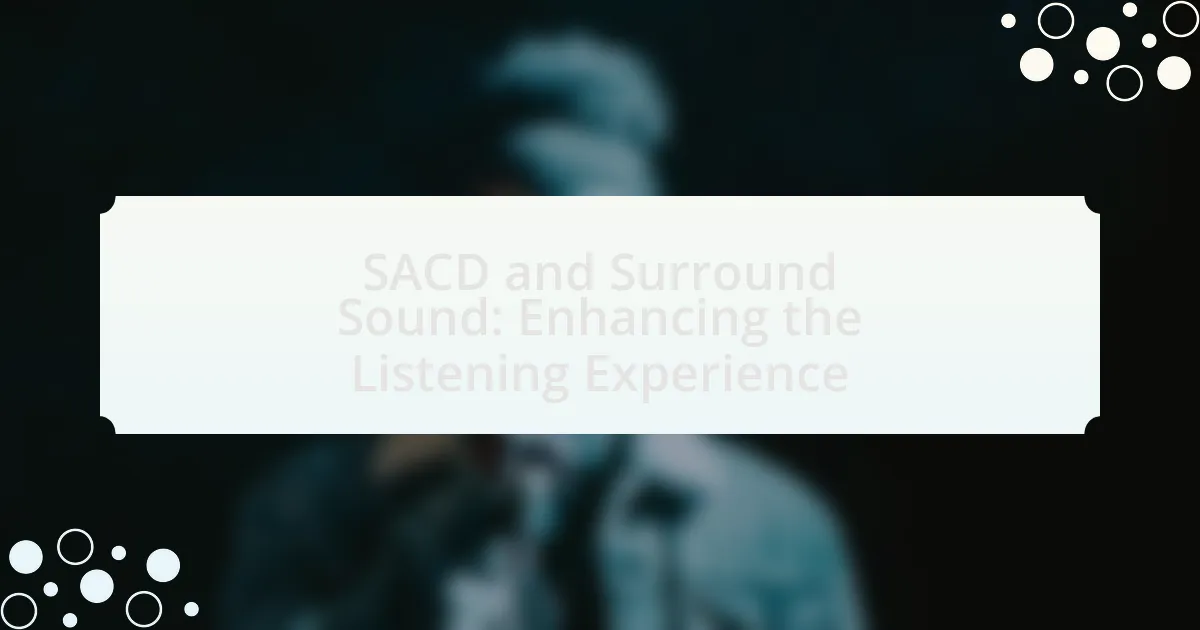SACD, or Super Audio CD, is a high-resolution audio format that supports multi-channel sound, providing an immersive listening experience that surpasses traditional audio formats. This article explores the key features of SACD, including its high sampling rates and hybrid disc capabilities, as well as the characteristics of Surround Sound systems that enhance audio realism. It discusses the importance of these technologies for audio enthusiasts, their role in modern music production, and the technical specifications that contribute to superior sound quality. Additionally, the article covers best practices for setting up SACD and Surround Sound systems to optimize the listening environment and improve overall performance.
What is SACD and Surround Sound?

SACD, or Super Audio CD, is a high-resolution audio format that supports multi-channel sound, allowing for a more immersive listening experience. Surround sound refers to audio systems that use multiple speakers to create a three-dimensional sound environment, enhancing the realism of audio playback. SACD combines these elements by offering high-quality audio reproduction and the capability to deliver surround sound, typically through formats like 5.1 or 7.1 channel audio. This format was developed by Sony and Philips in the early 2000s, aiming to provide a superior alternative to standard CDs by utilizing a higher sampling rate and bit depth, which results in clearer and more detailed sound.
How do SACD and Surround Sound differ from traditional audio formats?
SACD (Super Audio CD) and Surround Sound differ from traditional audio formats primarily in their audio quality and multi-channel capabilities. SACD utilizes a higher sampling rate and bit depth than standard CDs, allowing for greater dynamic range and fidelity, while Surround Sound provides a multi-channel audio experience that immerses listeners in a three-dimensional sound environment, unlike the stereo sound of traditional formats. Traditional audio formats typically offer two-channel stereo sound, limiting the spatial audio experience. SACD supports both stereo and multi-channel audio, enhancing the listening experience with superior sound quality and depth.
What are the key features of SACD?
The key features of SACD (Super Audio CD) include high-resolution audio, multi-channel sound capabilities, and a hybrid disc format. SACD supports audio sampling rates up to 2.8224 MHz, which is significantly higher than standard CDs, allowing for greater detail and clarity in sound reproduction. Additionally, SACD can deliver multi-channel audio, providing an immersive listening experience by utilizing up to six channels of sound. The hybrid format allows SACDs to be played on standard CD players, making them accessible while still offering enhanced audio quality on compatible SACD players. These features collectively contribute to SACD’s reputation for superior sound quality compared to traditional audio formats.
What are the characteristics of Surround Sound systems?
Surround Sound systems are characterized by their ability to create an immersive audio experience by utilizing multiple audio channels and speakers positioned around the listener. These systems typically include a minimum of five channels: front left, front right, center, surround left, and surround right, often supplemented by a subwoofer for low-frequency effects. The arrangement of speakers allows for sound to come from various directions, enhancing the realism of audio playback in movies, music, and gaming. Surround Sound formats, such as Dolby Digital and DTS, encode audio in a way that allows for precise placement of sounds in a three-dimensional space, contributing to a more engaging listening experience.
Why are SACD and Surround Sound important for audio enthusiasts?
SACD and Surround Sound are important for audio enthusiasts because they provide superior audio quality and immersive listening experiences. SACD, or Super Audio CD, utilizes high-resolution audio formats that exceed the fidelity of standard CDs, allowing for greater detail and clarity in sound reproduction. Surround Sound enhances this experience by creating a multi-dimensional audio environment, enabling listeners to perceive sound from multiple directions, which closely mimics real-life acoustics. This combination of high-resolution audio and spatial sound significantly elevates the overall listening experience, making it more engaging and lifelike for enthusiasts who prioritize sound quality.
How do they enhance the listening experience?
SACD and surround sound enhance the listening experience by providing higher audio fidelity and immersive soundscapes. SACD, or Super Audio CD, utilizes advanced encoding techniques that allow for a broader frequency range and greater dynamic range compared to standard CDs, resulting in clearer and more detailed sound reproduction. Surround sound systems create a three-dimensional audio environment by using multiple speakers positioned around the listener, which allows for a more engaging and realistic listening experience. Research indicates that listeners often report increased emotional engagement and satisfaction when experiencing music in surround sound formats, as it replicates the spatial characteristics of live performances.
What role do they play in modern music production?
SACD and surround sound play a crucial role in modern music production by providing enhanced audio quality and immersive listening experiences. These formats allow producers to create multi-dimensional soundscapes, enabling listeners to perceive music in a more engaging way. For instance, SACD supports higher sampling rates and bit depths compared to standard CDs, resulting in clearer and more detailed sound reproduction. Additionally, surround sound technology allows for the placement of audio elements in a three-dimensional space, which can significantly enhance the emotional impact of a musical piece. This capability is particularly valuable in genres such as film scores and live recordings, where the goal is to replicate a realistic auditory environment.
How does SACD technology work?

SACD technology works by utilizing a high-density optical disc format that supports both stereo and multi-channel audio, providing superior sound quality compared to standard CDs. It employs Direct Stream Digital (DSD) encoding, which captures audio at a much higher sampling rate than traditional PCM formats, allowing for a more accurate representation of sound. This technology enables the playback of audio with a frequency response up to 100 kHz and a dynamic range of over 120 dB, significantly enhancing the listening experience. The combination of DSD encoding and multi-channel capabilities allows SACD to deliver immersive surround sound, making it a preferred choice for audiophiles and music enthusiasts.
What are the technical specifications of SACD?
The technical specifications of Super Audio CD (SACD) include a storage capacity of up to 4.7 GB for single-layer discs and 8.5 GB for dual-layer discs. SACD utilizes Direct Stream Digital (DSD) encoding, which operates at a sampling rate of 2.8224 MHz, significantly higher than the standard CD’s 44.1 kHz. This format supports multi-channel audio, allowing for up to six channels (5.1 surround sound) and provides a dynamic range of up to 120 dB. The SACD format also includes a CD layer for compatibility with standard CD players, ensuring broader accessibility. These specifications contribute to SACD’s reputation for high-fidelity audio reproduction.
What audio formats does SACD support?
SACD supports two main audio formats: DSD (Direct Stream Digital) and PCM (Pulse Code Modulation). DSD is the primary format used for high-resolution audio on SACDs, allowing for a sampling rate of 2.8224 MHz, which is significantly higher than standard CD audio. PCM is also supported, typically at higher bit depths and sample rates, enabling compatibility with various audio systems. The SACD format was developed by Sony and Philips, and it was introduced in 1999, specifically designed to provide superior sound quality compared to traditional CDs.
How does SACD achieve higher sound quality?
SACD achieves higher sound quality through its use of Direct Stream Digital (DSD) encoding, which captures audio at a much higher sampling rate than standard CDs. This method allows for a more accurate representation of sound waves, resulting in greater detail and clarity. The DSD format operates at a sampling rate of 2.8224 MHz, compared to the 44.1 kHz of CDs, enabling SACD to reproduce a wider frequency range and dynamic range. Additionally, SACDs can support multi-channel audio, enhancing the immersive listening experience by providing sound from multiple directions, further contributing to perceived sound quality.
What is the process of creating an SACD?
The process of creating a Super Audio CD (SACD) involves several key steps. First, audio is recorded in high-resolution formats, typically using Direct Stream Digital (DSD) technology, which captures sound at a higher fidelity than standard CDs. Next, the recorded audio is mixed and mastered to ensure optimal sound quality, often incorporating surround sound formats to enhance the listening experience. Finally, the mastered audio is encoded and burned onto a dual-layer disc, allowing for both high-resolution stereo and multi-channel playback. This process ensures that SACDs deliver superior audio quality, making them a preferred choice for audiophiles.
How does the mastering process differ for SACD?
The mastering process for SACD differs primarily due to its capability to handle higher resolution audio formats and multi-channel sound. Unlike standard CDs, SACDs utilize Direct Stream Digital (DSD) encoding, which requires mastering engineers to adapt their techniques to preserve the audio quality and dynamic range inherent in DSD. This involves using specialized equipment and software that can process DSD files, ensuring that the final product maintains the fidelity and immersive experience that SACD is designed to deliver. Additionally, the multi-channel aspect of SACD necessitates careful balancing and spatial placement of audio elements, which is not typically a focus in traditional CD mastering.
What equipment is necessary for SACD production?
The equipment necessary for SACD production includes a high-resolution audio workstation, SACD authoring software, a DSD (Direct Stream Digital) converter, and a mastering system capable of handling DSD formats. High-resolution audio workstations are essential for editing and mixing audio tracks, while SACD authoring software is required to create the SACD disc structure. The DSD converter is crucial for converting PCM audio to DSD format, which is used in SACDs. Additionally, a mastering system that supports DSD is needed to ensure the final product meets the quality standards of SACD.
What are the benefits of using Surround Sound?

The benefits of using Surround Sound include an immersive audio experience that enhances the perception of space and depth in sound. This technology allows listeners to hear sounds from multiple directions, creating a more realistic and engaging listening environment. Studies have shown that Surround Sound can improve the enjoyment of music and movies by providing a more dynamic range of audio, which can lead to increased emotional engagement and satisfaction. For instance, research indicates that listeners often report a heightened sense of presence and realism when experiencing audio in a Surround Sound format compared to traditional stereo systems.
How does Surround Sound improve audio immersion?
Surround sound improves audio immersion by creating a three-dimensional audio environment that enhances the listener’s experience. This technology utilizes multiple audio channels and speakers positioned around the listener, allowing sounds to come from various directions, mimicking real-life acoustics. Research indicates that surround sound systems can significantly increase the perception of depth and space in audio playback, leading to a more engaging and realistic listening experience. For instance, studies have shown that listeners can identify sound locations more accurately in surround sound setups compared to traditional stereo systems, which reinforces the immersive quality of the audio.
What are the different Surround Sound formats available?
The different Surround Sound formats available include Dolby Digital, DTS (Digital Theater Systems), Dolby Atmos, and Auro-3D. Dolby Digital is widely used in DVDs and Blu-rays, providing 5.1 channels of audio. DTS offers similar capabilities but is known for higher bit rates, resulting in better sound quality. Dolby Atmos enhances the experience by adding height channels, allowing sound to move in a three-dimensional space. Auro-3D provides a unique approach with its three-layered sound structure, creating an immersive audio environment. Each format has distinct characteristics that contribute to the overall listening experience in home theaters and professional audio settings.
How does speaker placement affect Surround Sound quality?
Speaker placement significantly affects Surround Sound quality by influencing soundstage, imaging, and overall immersion. Properly positioned speakers create a cohesive audio environment, allowing sounds to emanate from specific directions, which enhances the listener’s perception of space and depth. For instance, placing surround speakers at ear level and at an angle of approximately 110 to 120 degrees from the listening position optimizes the surround effect, as recommended by the Dolby Atmos guidelines. This strategic placement ensures that sound waves reach the listener in a way that mimics a natural auditory experience, thereby improving clarity and reducing sound distortion.
What are common applications of Surround Sound?
Common applications of Surround Sound include home theater systems, gaming, music production, and virtual reality experiences. In home theater systems, Surround Sound enhances the cinematic experience by providing immersive audio that matches the action on screen. In gaming, Surround Sound allows players to perceive directional audio cues, improving gameplay and realism. In music production, Surround Sound is used to create a more engaging listening experience, allowing for spatial audio mixing. Additionally, virtual reality experiences utilize Surround Sound to create a realistic environment, enhancing user immersion. These applications demonstrate the versatility and effectiveness of Surround Sound in various entertainment mediums.
How is Surround Sound utilized in home theaters?
Surround sound is utilized in home theaters to create an immersive audio experience that enhances the viewing of movies and listening to music. This technology employs multiple audio channels and speakers positioned around the viewer, allowing sound to come from various directions, which mimics real-life acoustics. For instance, a typical 5.1 surround sound system includes five speakers and one subwoofer, strategically placed to envelop the audience in sound, thereby increasing the realism and emotional impact of the content. Studies have shown that surround sound significantly improves user engagement and satisfaction, making it a preferred choice for home theater setups.
What role does Surround Sound play in gaming and virtual reality?
Surround Sound significantly enhances the immersive experience in gaming and virtual reality by providing a three-dimensional audio environment. This audio technology allows players to perceive sound from multiple directions, creating a realistic auditory landscape that complements visual elements. Research indicates that 3D audio cues improve spatial awareness and reaction times in gaming, leading to better performance and engagement. For instance, a study published in the Journal of the Audio Engineering Society found that players using surround sound systems demonstrated a 30% improvement in locating sound sources compared to those using stereo sound. This capability is crucial in virtual reality, where accurate sound positioning can enhance the sense of presence and realism, making interactions feel more lifelike.
What are best practices for setting up SACD and Surround Sound systems?
To set up SACD and Surround Sound systems effectively, ensure proper speaker placement, use high-quality cables, and calibrate the system for optimal sound. Proper speaker placement involves positioning speakers at ear level and creating an equilateral triangle between the listener and the front speakers, which enhances soundstage and imaging. High-quality cables minimize signal loss and interference, ensuring the best audio quality. Calibration, often done using built-in system tools or external calibration microphones, adjusts speaker levels and distances to create a balanced sound environment, which is crucial for achieving the immersive experience that SACD and Surround Sound systems are designed to provide.
How can users optimize their listening environment?
Users can optimize their listening environment by controlling sound reflections and minimizing background noise. This can be achieved by using acoustic panels to absorb sound, placing rugs or carpets to reduce floor reflections, and ensuring that speakers are positioned correctly to create an optimal soundstage. Research indicates that proper speaker placement can enhance sound quality significantly, with a study showing that positioning speakers at ear level and forming an equilateral triangle with the listening position improves audio clarity and immersion. Additionally, eliminating sources of noise, such as turning off appliances and using soundproofing materials, further enhances the listening experience.
What troubleshooting tips can enhance performance?
To enhance performance in SACD and surround sound systems, ensure proper speaker placement and calibration. Correct positioning of speakers according to the room’s acoustics can significantly improve sound quality. For instance, placing speakers at ear level and equidistant from the listening position optimizes sound staging and clarity. Additionally, using a sound level meter to calibrate speaker volumes ensures balanced audio output, which is crucial for an immersive listening experience. Regularly updating firmware and software for audio equipment can also resolve compatibility issues and enhance overall performance.

Leave a Reply